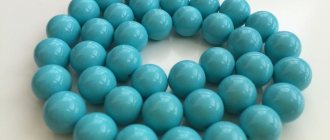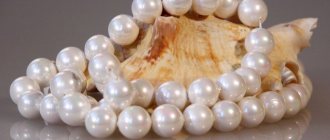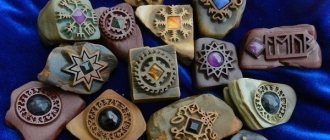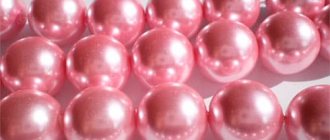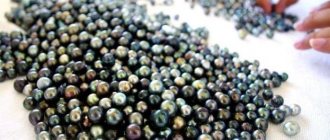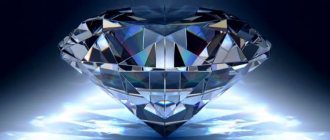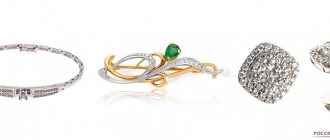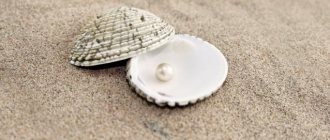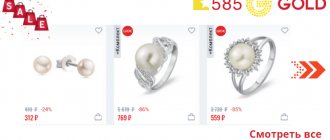Hello! Today we’ll talk about what the most expensive pearls in the world are, make a rating of products with exclusive pearls, and name real prices. But first, a little about how it all began and how pearls were grouped in ancient times, highlighting elite samples. On the first maps, the coast of the Persian Gulf was called nothing less than the “Pearl Coast”. In past centuries, mother-of-pearl balls were mined mainly in the South Seas, but pearls from the Persian Gulf were considered the most expensive and valuable. For many centuries in a row, Persian pearls have had no equal in the world.
Europeans called them the beautiful word “oriental” and believed that all pearls from the Gulf fell into this category. The Arabs had a different opinion, dividing Persian booty into several categories depending on external features. The largest ones fell under “race” groups. The middle ones called “zil” and “batn”. There was no name for ideal peas in Arabic, so a special Indian version, “jayun,” was chosen for them.
All finds from the Gulf were distinguished by their rounded shape and smooth surface. It was a valuable and sought-after first-class product. Second-class pearls were distinguished by more modest sizes, irregular shapes and, depending on individual characteristics, were called “naim”, “badalya” or “futyava”.
Cowdray natural black pearl necklace – $5.3 million
The beauty of the natural black Cowdray pearl necklace continues to captivate the world, so much so that in just 3 years between the sale of the jewelry, it broke its own record, adding $2 million in price. A beautiful single-strand necklace of 42 Tahitian sea pearls sold for US$5.3 million at Sotheby's Hong Kong.
Types of pearls
The color of a pearl is determined by many factors in the formation of the stone. The shape, shade, and size of the pearl are determined gradually, throughout the entire period of formation of the stone, and in natural conditions this often takes years.
The qualities of future jewelry are influenced by:
- the variety of shellfish in which it grows;
- water temperature and composition;
- the presence of a current in the place of growth.
Pearls can grow in fresh or sea water, which significantly affects its appearance and cost.
Types of sea pearls
At the moment, the extraction of pearls from the depths of the ocean, in wild shellfish, is not very common. The widespread practice of harvesting pearls in this barbaric manner in past centuries affected the biodiversity of the ocean, as up to a ton of shells were required to obtain a few pearls.
Nowadays, pearls are mined on cultivated plantations, where the quantity and quality of the future stone can be controlled and branded varieties can be grown in large quantities.
What color are pearls?
The most common is white pearls. The first plantation that cultivated it used oysters called acoya, which gave the variety its name. Akoya pearls are now grown in China, Japan and Vietnam. These are light varieties of pearls, pure white or colored in various shades of silver, pink, and champagne. The most valuable shade of this variety is pearl with a green or pink tint and bright shine.- Tahitian pearls, on the other hand, are distinguished by a variety of dark shades. Among this variety you can find black pearls with various shades, as well as blue, brown and gray pearls. The most expensive stone among the dark range is green pearls, or rather dark ones with a green metallic tint. Regarding this variety, it should be noted that Tahitian pearls are not grown on the island itself. Tahiti is the name of a center engaged in the cultivation of oysters and the sale of pearls.
- South Sea pearls are the collective name for light-colored pearls that are grown in a large breed of mollusk. This pearl is very expensive because of its special structure - it has the thickest layer of nacre, unlike other varieties. Due to this, the pearl has a matte silk shine that you will not find in any other variety. This variety includes gold pearls, white pearls with a silver tint, and champagne beige pearls.
The Cortez variety is grown off the coast of Mexico. This is also a fairly expensive dark variety (but not as dark as Tahitian pearls - natural black pearls grow only there). The types of pearls grown in this variety are colored pearls in golden, graphite, brown and silver shades. These pearls are distinguished by their rich iridescence, reminiscent of a puddle of gasoline.
All of the above varieties of pearls grow in seawater and are distinguished by their large size and strong shine caused by aggressive salt water.
Freshwater pearls and their types
But there are also plantations of freshwater pearls, distinguished by their unique colors and shades. Freshwater pearls are typically less expensive due to their irregular shape, subdued matte shine, and high harvest volumes. Varieties of freshwater pearls:
Kasumi pearls are a type of pearl grown in Japan at Lake Kasumi-ga-ura. It has a thick layer of mother-of-pearl, but very rarely forms round beads and a smooth surface.However, the iridescence of its colors makes these colored pearls extremely popular among jewelry designers who can play with the unique shape of the pearl in their products. Kasumi pearls come in a variety of colors from white to deep black. Among this variety you can see pink pearls, lavender, lilac, green pearls and all sorts of iridescent shade combinations.
- Keshi is also a Japanese type of pearl that consists entirely of mother-of-pearl and has no core. Previously, such pearls were considered “defective” because of their flat concave shape, reminiscent of a plucked petal, but now, thanks to their beautiful shine and noble iridescence, these pearls are used to make various jewelry compositions, buttons, etc. These pearls come in both light and dark shades, and the most popular are their lavender and pistachio color variations.
Biwa is another type of irregularly shaped pearl that is also mined in Japan. Biwa pearls do not have a core, which is why they form peculiar stalactites of pure mother-of-pearl. The color variations are endless - pink pearl, gold, beige, blue pearl, green and graphite - any shade can be found among these unique pearls.
Baroda pearl necklace – $7.1 million
The Baroda necklace is made of 68 cream and soft pink pearls and ends with a Cartier diamond clasp. Previously, the decoration was sold for $3.13 million, and during the latest auction it broke its own record, going under the hammer for $7.1 million at Christie's auction in New York.
Philippine nugget
Who would have thought that a real treasure in the form of a giant pearl would be hidden under the bed of a humble Filipino fisherman? And most importantly, he was absolutely unaware of the value of his find, which he accidentally discovered and raised from the bottom of the ocean. According to rough estimates, the cost of the pearl is about 100 million dollars. For ten years she lay in “obscurity”, acting as a kind of amulet. Before going out to sea, the fisherman touched it, believing in his luck.
The story would have remained unpublished if His Majesty Chance had not intervened. Due to the move, the young man had to give his talisman to his aunt for temporary storage. The weight of the pearl is almost 34 kg, its width is 67 cm, and its length is 30 cm. By coincidence, a relative worked in the tourism industry and, having seen such a “phenomenon,” persuaded her nephew to show the find to the local authorities. After examining the pearl by experts and recognizing its naturalness, it has every chance of being immortalized in the Guinness Book of Records.
The story of her discovery is surprising and banal at the same time. Going out to sea to fish, the future millionaire caught his anchor on some heavy object. Diving under the water, he saw a large mollusk, in which, after being lifted onto land and opened, the notorious pearl was discovered. It has a non-standard arched shape, resembling convex cartilage, but this fact in no way detracts from its value and natural beauty.
La Peregrina necklace – $11.8 million
It's hard to say whether La Peregrina is one of the most expensive pearl necklaces in the world because of the 50.6-carat pearl or because it belonged to the famous Elizabeth Taylor. The actress received the jewelry as a Valentine's Day gift from her husband Richard Burton. The necklace previously belonged to the Royal Family of Spain and then to the Duke of Abercorn.
The La Peregrina necklace remained in the family collection for nearly a century until Burton purchased it at auction in 1969 for $37,000. In December 2011, the piece was sold as part of the Elizabeth Taylor collection and brought in $11.8 million at Christie's in New York.
Advertising - Continued below
The European pearl market: how it developed and what was in price
The work of a pearl appraiser was considered one of the most honorable. Like a sommelier, the masters analyzed the parameters of pearl peas and determined the cost.
In those days, pearls of matte white color with a delicate pink tint were considered the most valuable. They were called "javahir". Next came pearls of rich pink color “nabati”. Peas of blue, greenish-gray, and purple colors were valued. They didn’t come across that often, so they were considered a gift of fate.
Large and rare beads were used mainly for inlaying bracelets, pendants and earrings. Medium and small peas were considered suitable for necklaces and decorating the outfits of members of the nobility, including in Russia. It is noteworthy that the famous Persian pearls were worn not by the emperor’s wife, but by the daughter of her favorite Count Orlov, Countess Anna Orlova-Chesmenskaya.
By the end of the 19th century, a special attitude towards the best pearls in the world and in the Romanov family had formed. The ruler’s wife, according to tradition, on her birthday presented each of her four daughters with a large pink pearl of the most valuable “javahir” variety. By the age of 18, the imperial daughters had enough pearls for a small pink necklace.
Since its discovery, pearls have fascinated and delighted people with their natural beauty and radiance. It is not surprising that its best examples have become symbols of wealth, status and wisdom.
Noble and influential people of the world considered it their duty to have the best pearls. Among them at one time was Cleopatra. To confirm her own power, the queen arranged the most expensive dinner in the history of mankind. To do this, she did not need to order hundreds of dishes and expensive wines. One trick made it priceless: Cleopatra dissolved the mother-of-pearl sphere in a glass of wine and drank its contents.
The best pearls in the jewelry collection were owned by famous women of the world, including Chanel, Taylor and Boleyn. All of them owned the best specimens of wild pearls of impeccable shapes, colors and sizes.
Classification of pearls by quality
In addition to individual aesthetic preferences, such as the color of pearls, there are also formal jewelry criteria for evaluating pearls. So, which pearls are considered the most valuable? There are several criteria for evaluating pearls:
Pearl color. As already mentioned, depending on the breed of mollusk and growing conditions, the color of the pearl may change. When assessing the color of a stone, attention is paid to the purity of the color, the uniformity of the color of the pearl, and the play of shades. In addition, dark colored pearls, especially those with a blue or green tint, are valued slightly higher than others.- The shine of a pearl. Simply put, the brighter a pearl shines, the higher its value. For a detailed assessment of an individual stone, various studies can be carried out to reveal the exact thickness of the mother-of-pearl layer.
- Ideal spherical shape. In addition to the ball, pearls can form all sorts of geometric shapes - a drop, a hemisphere, a rice shape, buttons, etc. However, one should not forget that the criterion of value affects only the cost of the stone; in fact, jewelers can create delightfully executed expensive compositions from “wrong” stones.
- Surface smoothness. This indicator applies only to pearls of spherical color and demonstrates the absence of defects, purity and radiance of the top layer of the pearl.
Size. Everything is simple here: the larger the pearls, the more expensive they are. In jewelry, the most expensive pearls reach sizes of 1.5-2 cm in diameter. History knows cases of discovering truly gigantic pearl samples - the most famous example is the Pearl of Allah, which weighs more than 7 kg.
The formal designations for pearl grades are AAA-A and AD. These are different classifications, the highest grade being AAA and the lowest being D.
Pearls whose class uses letters other than A are considered unsuitable for jewelry making and are not used in jewelry.
The highest class is assigned to pearls that are practically free of surface defects, have a pure color, an even beautiful shine and a regular shape. There are very few such stones. The lower stages of the classification are occupied by pearls with any defects, but if defects occupy more than a quarter of the stone, then it is not allowed to enter the jewelry machine.
What is the name of the world's largest pearl?
The Pearl of Puerto, also called the Pearl of Puerto Princesa, is the largest known naturally occurring pearl in the world. Was found by a Filipino fisherman in the Philippine Sea. Its length is 67 cm, width 30 cm and weight 34 kilograms.
Interesting materials:
How to find out the total number of electrons in an atom? How to find out the original Nike? How can you tell whether cigarettes are original or not? How to find out the loan balance at Rosbank? How to find out where thank you bonuses are awarded? How to find out your company's suppliers? How to find out the reason for the power outage? How to find out the percentage difference between numbers? How to find out the bitness of Office 2016? How to find out the cross-section of an aluminum cable?
Diamond
The most expensive jewelry stone consists of a single chemical element - it is based on pure carbon atoms. There are several hypotheses about the origin of diamonds; the most common one is that diamond deposits were formed in the Earth’s mantle under pressure, and then were thrown out by magma into the rock with a so-called “explosion tube.” Scientists cannot specifically determine the age of diamonds, believing that it ranges from 900 million to 2.5 billion years.
The most expensive stone in the world is diamond
There are a huge number of varieties of diamonds. Jewelers talk about a thousand types, differing in color, shape, purity, and shine. The dream of any diamondsmith is to find a completely transparent stone, because the more colorless the diamond, the higher its value. But this rule does not apply to colored diamonds: blue, red, pink, yellow and green diamonds are extremely rare and cost many times more.
Colored diamonds are almost impossible to find in nature
The most expensive diamond
The most expensive diamond in the world is called “Cullinan” - “Star of Africa”.
In 1905, it was discovered in one of the mines in South Africa. Having examined the extracted jewel, the miners realized that before them lay something grandiose: the stone weighed 530 grams (3106 carats) and did not have any defects except a black spot in src=»https://uznayvse.ru/images/stories2015/uzn_1457093869. jpg" class="aligncenter" width="560″ height="330″[/img] Mine owner Thomas Cullinan with the found treasure
In 1907, it was presented to the British monarch Edward VII, who entrusted the cutting to the Dutch company. For several months, the best cutter in Europe, Joseph Ascher, studied the stone. Unfortunately, there were cracks in the stone, so it was impossible to make one colossal diamond. Asher meticulously calculated the breaking point and broke the diamond into 9 large stones and 96 small fragments, losing consciousness from excitement upon impact. Every part of the giant was used in royal decorations. The largest fragment, weighing 530 carats, went into the scepter of Edward VII. The second largest fragment adorns the crown of the British Empire.
Cullinian-I - the largest fragment of the legendary Star of Africa
